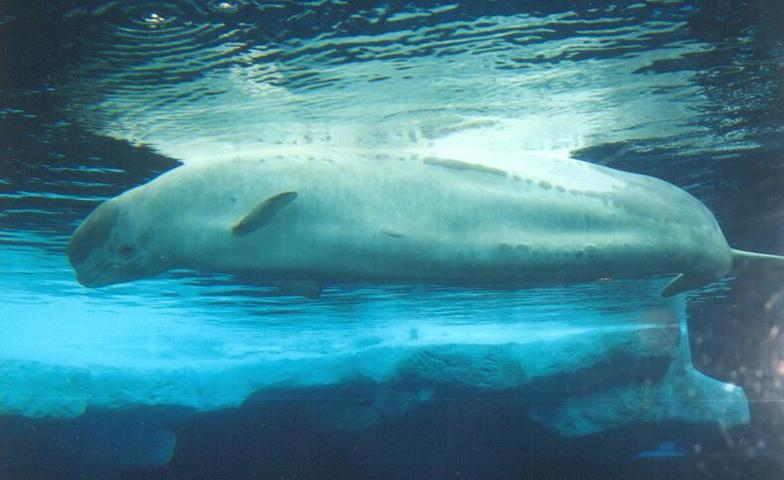Delphinapterus
Dinner
The Beluga belongs
to the Family Monodontidae, which classifies them as
"toothed whales". Yet, they only have teeth to catch
the prey not to actually chew it. The beluga does
not have a sense of smell to catch prey, so it relies on it's
good eyesight and excellent hearing. It is thought that they
use their nasal sacs by their blowholes to make noises and
use echolocation. Even though they have good
eyesight and hearing, they do not use their good senses but
instead most of the beluga's diet is composed
of bottom feeding and eating sea bed creatures. When bottom
feeding the beluga will dive down for about 25 minutes and
siphon through the sediment and actually just
inhale the food without
chewing. They mainly
forage for invertebrates in the sand but also do have a
taste for halibut, cod, squid and other fish.
How Do
Belugas "Work"?
Digestive
System/ Thermoregulation
The Beluga whale
transports its food through it's digestive system like most other mammals but because they
are large animals their metabolism is much slower than most.
They consume up to 5%
(50-75 lbs) of their body
weight everyday and blubber accounts for 40% of their body
weight. Because they are slow moving animals only
some of the food is used for energy. Most of their food
intake is turned into fatty blubber and the blubber is insulation
for the whale.
Circulatory System
Belugas have a circulatory system, again,
like most other mammals. Blood circulates throughout the
body, but with a very limited amount of blood circulation
through the pectoral fins and the tail. Yet, unlike most
mammals, the arteries in the
flippers and flukes (tail) are surrounded by veins. This
layout creates a system that instead of the heat leaving the
arteries and out into the environment, the heat is transferred back to
the veins and brought back into the body . The system described is
a countercurrent heat
exchange and is effective in minimizing heat loss
in the cold Arctic Waters.
Another way that belugas conserve heat is by shunting
(limiting blood flow) to the skin while diving to the ocean
floor. By shunting blood away from the skin it keeps the heat
inside their body and limits the loss of heat as well.
Respiratory System
When the Beluga shunts blood away from it's skin
it also contributes to maximizing the amount of air that the
Beluga needs while diving. From shunting the blood away from
the skin it provides more oxygen to the heart, lungs and
brain where it is needed. Belugas are not considered deep diving
whales but are fully able to make dives deeper than 2,000
feet but on average only dive for about 5 minutes at a depth
of 20 ft. Belugas have the oxygen binding protein
myoglobin which stores oxygen
and provides the whale with a higher oxygen percentage in
their blood. The myoglobin also helps the blood contain more
oxygen to help prevent oxygen deficiency to the muscles
while diving. Also, during dives, the Beluga's
heart rate slows (typical of
whales) during diving, it can slow from 100 down to 20 beats
per minute, this allows maximum oxygen use.

Picture Permission By: Hejda, E.
2006. The Animal Diversity Web (online). |